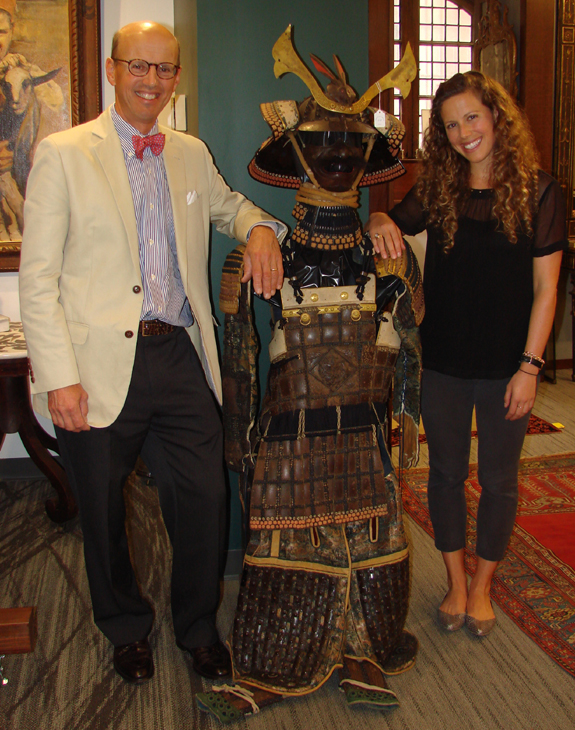Review and Onsite photos by Rick Russack;
Catalog Photos Courtesy of Grogan & Company
BOSTON, MASS. — The father and daughter team that conducts the Grogan & Company auctions had another successful sale on September 27. A total of 200 lots were sold, with a respectable average price of $5,000 per lot. Michael Grogan and daughter Lucy collaborate on fine arts, and Lucy is responsible for jewelry and conducts that portion of the sale from the podium. The first 86 lots included paintings and sculpture, and the day’s highest grossing item fell into this session: a Rodin bronze brought $73,200, and several paintings exceeded their high estimates.
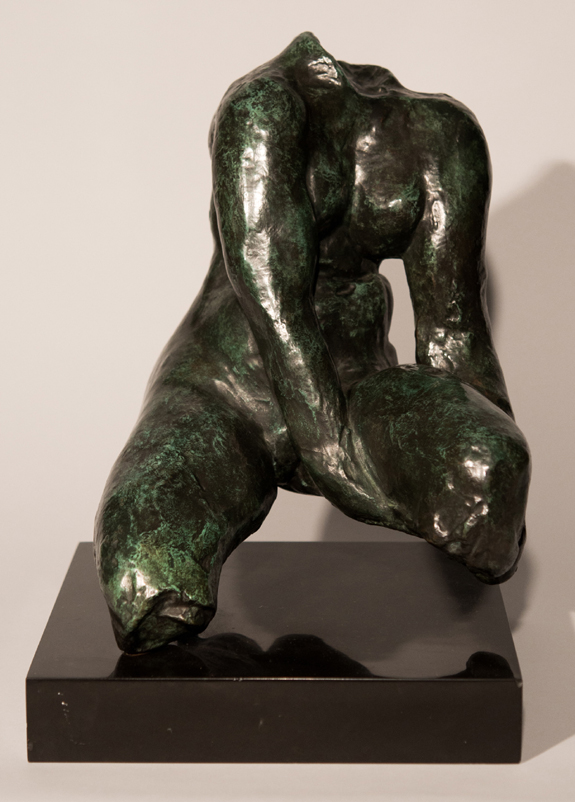
The top lot of the day was a bronze by Auguste Rodin. “Torse feminin assis dit ‘Torse Morhardt,’” grand modele, was conceived by the sculptor but never cast in his lifetime. It sold to a Midwestern buyer for $73,200.
The sale included a Lemuel Curtis girandole clock that sold over the estimate, an Albert Paley Aesthetic Movement lectern, Japanese armor, silver and Oriental rugs. There were about 50 people in the salesroom, several phones were active, and many lots drew attention from Internet bidders. Few lots were unsold.
When Auguste Rodin (French, 1840–1917) died, he left his entire estate to his native France. The bequest included his home and studio, all of his unsold sculpture and unfinished pieces, along with the right to continue to cast his works posthumously. Since Rodin’s death in 1917, the Musée Rodin in Paris has for the nation of France followed his directions. Its authorized posthumous casts are made either from his original plaster molds or from molds newly taken from his plasters. By a 1959 French law, posthumous editions of Rodin’s bronzes were limited to 12 castings.
The work that Grogan sold, “Torse feminin assis dit ‘Torse Morhardt,’” grand modele, was one of the works cast posthumously in 1956. It was number 5 of the edition. Conceived circa 1895 by Rodin, it had never been cast while the artist was living, and it was, therefore, rightly considered to be an original work. A collector on the phone outbid a woman in the salesroom, and it is on its way to a Midwest home.
Grogan always has a good selection of American and European paintings. Leading the category was a colorful oil on board by Impressionist Edward Henry Potthast (American, 1857–1927). “Wading” shows four young girls wading in the ocean. The artist was known for scenes of people at leisure on the beaches of New York and New England. The painting will be included in the forthcoming catalogue raisonné of the artist’s work. It sold for $48,800. Also doing well was a charcoal on paper work by Otto Dix (German, 1891–1969). Signed and dated 1919 and portraying a woman’s head, it sold for $45,750.
In 1988 it had been exhibited at the Rhode Island School of Design. Dix was known for his realistic depictions of Weimar society. Not far behind was an America’s Cup yachting scene by Montague Dawson (British, 1895–1973) titled “The Challenger.” The title refers to the British racing yacht Endeavor, which challenged Rainbow, the American defender of the cup, in 1934. Endeavor had last-minute crew problems and the Americans retained the cup. The 18-by-36-inch oil on canvas brought $39,650 from a phone bidder.
Another Dawson, a watercolor on paper depicting a large, fully rigged three-mast sailing vessel on a bright blue ocean, sold for $5,185. The sale included four equestrian portraits. Most sought-after was an oil on canvas by Edmund Charles Tarbell (American, 1862–1938). The 25-by-27-inch painting showed a mounted jockey in green and white livery, with water and sky in the background. It finished at $27,450, and an equestrian portrait of “Bushranger” by Henry Stull (American, 1851–1913) went out for $5,490.
During the preview, Antiques and The Arts Weekly asked Michael Grogan which was his favorite item in the sale. He pointed to an oil on canvas by John La Farge (American, 1835–1910), titled “Girl With The Ring,” a colorful portrait of a semi-nude young woman pensively looking at a ring in her hand. La Farge, perhaps best known for his stained glass work with Tiffany, had many other talents, including oil painting. Surprisingly, this painting went out under estimate at $12,200 and was probably a good buy for its new owner.
The sale included works by other well-known American artists. “Morning, Gloucester Harbor” by Emile Gruppe (American, 1896–1978), achieved $5,490, and a 1927 watercolor on paper, “Winter Hills” by Frank Weston Benson (American, 1862–1951), fetched $13,420. It showed snow-covered hills with blue conifers. An etching and drypoint, signed in the plate with a monogram and signed in pencil on a tab, by James Abott McNeill Whistler (American, 1834–1903) achieved $7,015. A lithograph by the same artist, “Charing Cross Railway Bridge,” made $2,074.
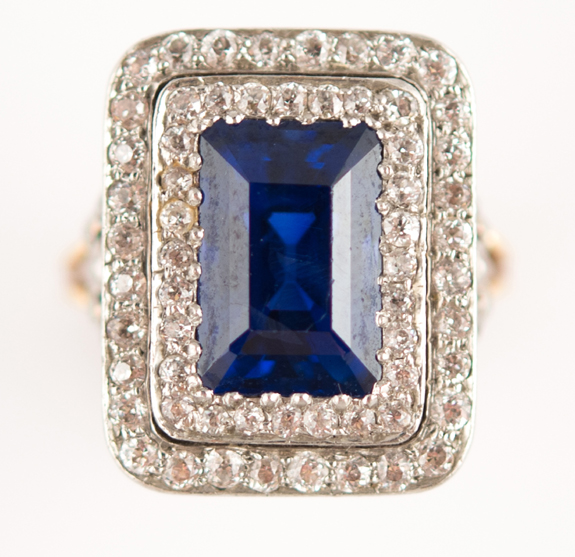
An ornately carved Art Deco Tiffany ring, in 14K yellow gold and platinum, with a large step-cut sapphire framed by two rows of single and full-cut diamonds, sold for $67,100.
Sold in the fine art portion of the sale was a portfolio “North American Indians, Hunting Scenes and Amusements” by George Catlin (American, 1794–1872). It contained 20 of 25 hand colored lithographs, mounted on board, each 17¾ by 12 inches. The portfolio was published in 1844 and included Catlin’s descriptive text. The set sold for $33,550. In 2012, Christie’s sold a complete example of this portfolio for $98,500.
Lucy Grogan is a strong believer in conservative estimates when it comes to jewelry. Two lots demonstrate this approach. A couple of days before the sale, when asked, she told Antiques and The Arts Weekly that her favorite item in the sale was a Tiffany 14K yellow gold, platinum, sapphire and diamond ring. The step-cut sapphire weighed 6.50 carats, framed by two rows of single and full cut diamonds, approximately 1.25 total carat weight. All are set in an ornately carved Art Deco setting. She said, “It’s an early Art Deco design, dating about 1910. It came from a wealthy Newport home and the sapphire, which is from Ceylon, is large and the quality is unsurpassed. The setting is beautiful, and I just think it’s really cool.”
When asked why she had estimated it at only $5,000, she explained her belief that conservative estimates encourage robust bidding, and said, “I really think it will bring more than $10,000.” She was right — it sold for $67,500. A 15-inch natural pearl necklace with 53 graduated pearls ranging from 4.56 to 9.90 millimeters and a diamond and platinum clasp was also estimated conservatively at $6,000. It was accompanied by a GIA certificate stating that the pearls were natural salt-water and showed no indications of treatment.
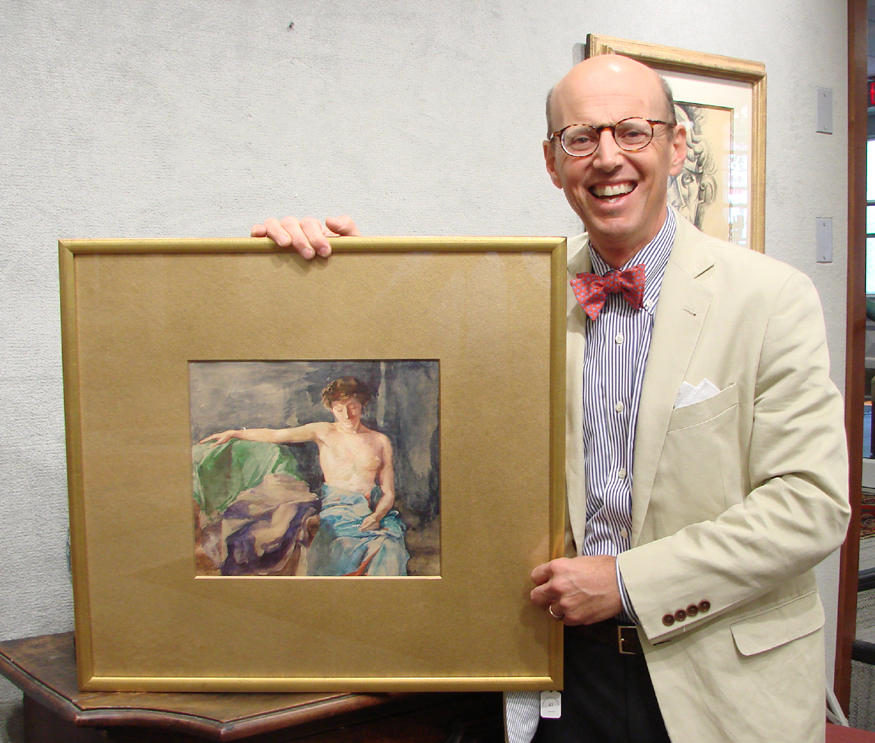
When asked what his favorite item in the sale was, Michael Grogan immediately pointed to the John La Farge painting “Girl With The Ring.”
Again, when asked about the estimate, she responded, “It will do very well, regardless of the estimate.” Right again — it brought the same price as the ring, $67,500. After the sale, Lucy said, “Across the board, jewelry prices were strong for all styles and periods. Signed pieces, particularly from the Art Deco period, continue to capture the eye of collectors and dealers alike, while the rarity of high-quality natural pearls fuels competitive bidding from around the world. We were very pleased with the results.”
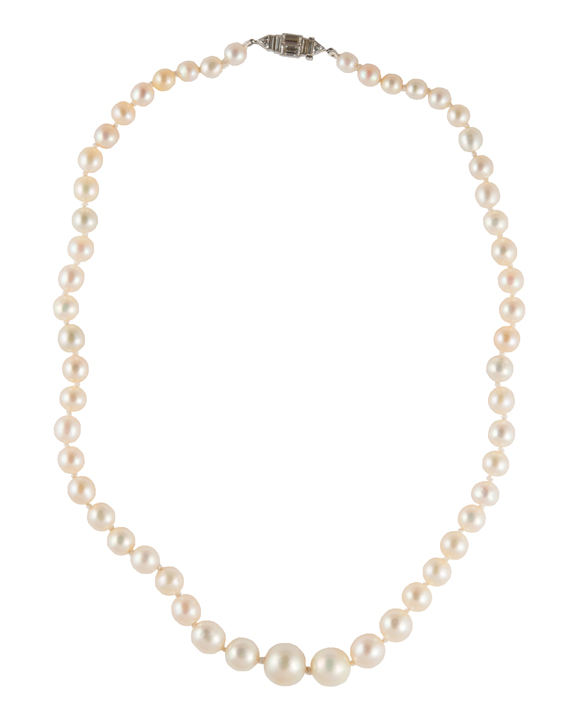
Far exceeding its conservative estimate, a natural pearl necklace with 53 graduated pearls and a diamond and platinum clasp, GIA certified, brought $67,100.
Other jewelry also did well. A pair of platinum, diamond, ruby and emerald dress clips earned $13,420. Each had full-cut diamonds, step-cut and carved rubies and sugarloaf cabochon emeralds. An attractive 18K yellow gold, diamond and ruby ring fetched $6,710. Another platinum, ruby and diamond ring, prong-set with an oval faceted ruby framed by ten old mine-cut diamonds went out at $14,640. A phone bidder, successful on a platinum and diamond line bracelet, told the person taking his bids that it was a present. The bracelet had 41 full cut diamonds, weighing about 2.50 total carat weight. One of the final lots in the jewelry portion of the sale was a men’s Patek Philippe yellow gold wristwatch with Roman numeral indicators enclosing a manual wind movement. Signed on the dial, apparently in working condition, it earned $5,490.
The sale included an example of the work of Albert Paley, an American metalworker born in 1944, who first started making and designing jewelry. The iron and brass lectern, or music stand, was created in 1971 and is the first piece of furniture Paley created. For a time, Paley was both making jewelry and working with metals. In 1974, at the age of 28, he submitted a design for the portal gates at the Renwick Gallery in Washington. He won the commission and the work solidified his reputation as a metalworker. Soon thereafter, he gave up jewelry making and devoted himself to working with iron and other metals. The music stand sold for $30,500, far exceeding its estimate of $5,000. Michael said that it was one of the “nice surprises” of the day.
Other decorative arts added to the variety of the sale. A signed 10½-inch green Lalique molded grasshopper vase finished at $15,860. A pair of 12-inch English table globes made by J&W Cary, with maps dated 1800, went for $7,320. A 25¼-inch coin-operated disc music box in an 80-inch upright walnut case brought $7,930. It had sold at Skinner in May 2005 for $11,750. A Seventeenth Century Japanese Tatami-Do-No-Gusoku suit of armor earned $12,200. It included 16 iron plates, which Japanese armor-makers incorporated after the introduction of firearms. The mempo was signed Munetsuna. A three-piece Chinese Export silver tea set ended up at $4,128, going to an Internet bidder, and a 175-piece set of flatware in the Chrysanthemum pattern by Tiffany went out at $15,860. A circa 1970 Isphahan carpet from Persia, 13 feet 7 inches by 10 feet 3 inches, finished at $12,200, and a late Nineteenth Century Serapi carpet from Persia, 15 feet 1 inch by 11 feet 4 inches, achieved $7,625.
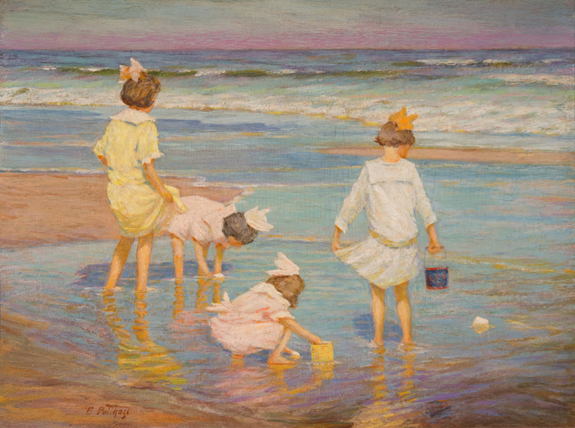
Leading the painting category was “Wading,” an oil on board by Edward Henry Potthast, an artist known for his seaside scenes. It earned $48,800.
After the sale, Michael told Antiques and The Arts Weekly that he was very pleased with the final numbers and commented on the challenge of drawing buyers to the salesroom. “We did well, grossing $1 million and averaging $5,000 per lot. We’re aiming for the higher end of the market, so these numbers are encouraging. Internet bidding was strong, and even when those bidders were not successful, their participation certainly helped prices.” Bidders in the salesroom, although perhaps not as many as we’d all like to see, were often buyers. One woman in particular bought a number of items, including paintings and jewelry, and was the underbidder on the Rodin bronze. She told Antiques and The Arts Weekly that she was not a dealer or a collector, but that she was buying for her home in Brookline, Mass. When asked if she had bought from Grogan’s before, she said yes, but usually on the Internet. Why did she stop bidding on the Rodin? “$60,000 is a lot of money,” she said.
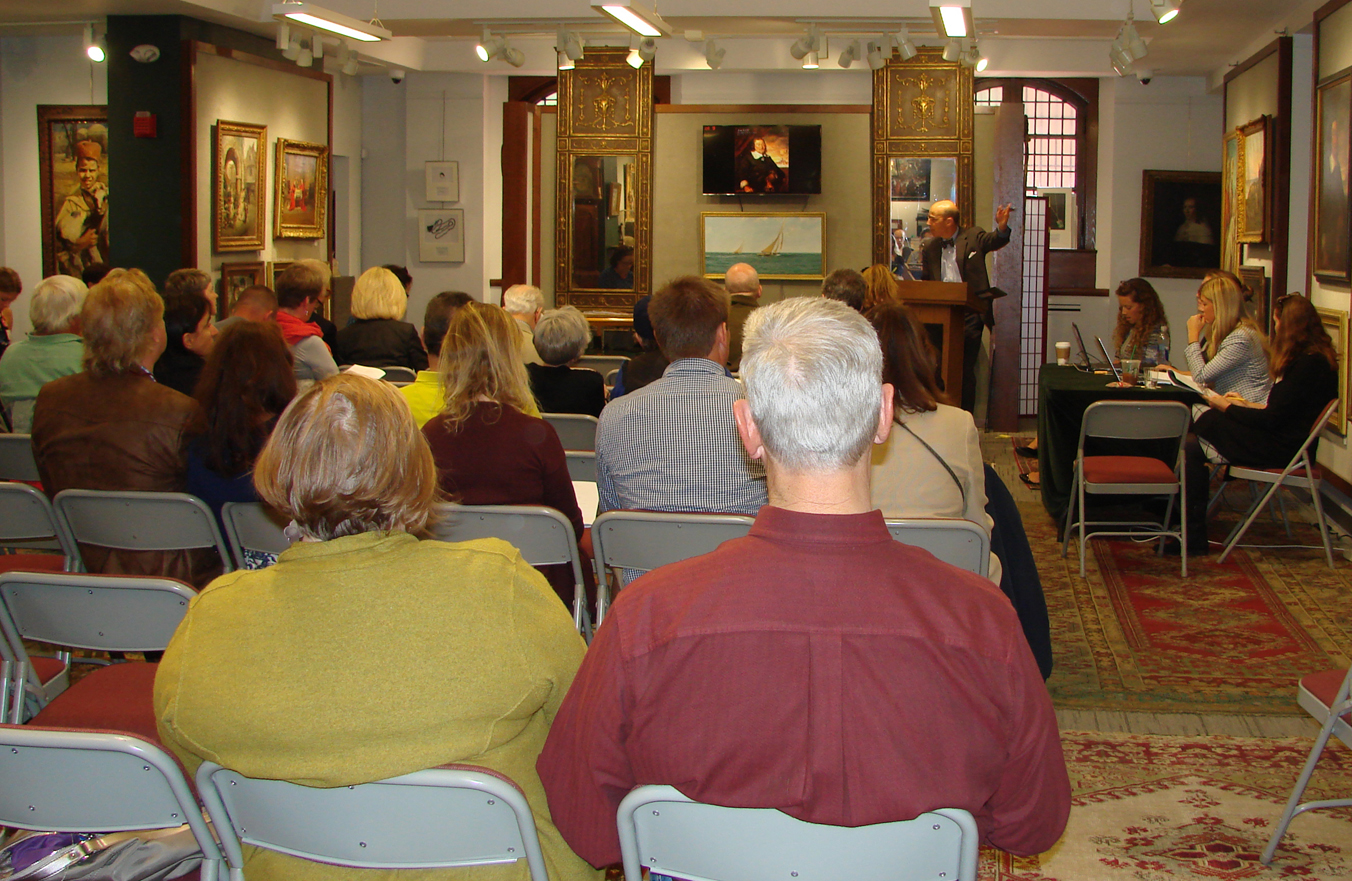
Although the salesroom had some empty seats, prices were not affected. The gallery is set up for easy viewing of all the lots.
All prices reported include buyer’s premium. For more information, 617-720-2020 or www.groganco.com.

